Mark Philippoussis
Born: November 7, 1976 in Melbourne (Victoria)
Height: 1.94 m
Plays: Right-handed
Μάρκος Φιλιππούσης – the son of a Greek father and an Italian mother, enjoyed the best year of his career in 1999. He managed to achieve something only Michael Stich (1993) had almost done before — he played a key role in securing three prestigious team titles for Australia: Hopman Cup, World Team Cup, and Davis Cup, winning three singles matches in each competition. That same year he captured the biggest of his eleven titles, triumphing at Indian Wells (his second and last final at this level comes from Paris 2000). However, a huge disappointment came at the Australian Open, where he lost in the fourth round and never reached the  quarterfinal stage in his home tournament. In 1999 he was perceived, perhaps for the only time in his career, as one of the favorites, given that in his previous major, the US Open ’98, he had reached the final.
quarterfinal stage in his home tournament. In 1999 he was perceived, perhaps for the only time in his career, as one of the favorites, given that in his previous major, the US Open ’98, he had reached the final.
Philippoussis’ second major final came in a rather unexpected period, when he was struggling with injuries and had dropped in the ATP rankings to No. 48. As in his previous best Slam run, he survived an intense quarterfinal: at the US Open ’98 against Thomas Johansson, and at Wimbledon ’03 against Alexander Popp.
The tall Australian first made an impact in 1995 as a 19-year-old. In just his fifth ATP event, Philippoussis [272] reached the final in Scottsdale as a qualifier, defeating four much higher-ranked opponents before playing a competitive match in the final against former No. 1 Jim Courier. He then received a wild card for Key Biscayne and reached the third round. Those two results, along with a final in Bologna, catapulted him from outside the Top 300 into the Top 100 within a few months.
His serve was tremendous – never before had a teenager served with such intensity. In Kuala Lumpur later that year he set a record for the number of aces in a three-set match (unbeaten for twenty years), hitting 44 against Byron Black. He took serving to a new level, surpassing even Goran Ivanišević, who at that time had not yet reached 40 aces in five-set matches. Brad Gilbert, then coach of Andre Agassi, predicted that the future would belong to Philippoussis. His serve was phenomenal, his volleys technically sound, and his ground-strokes powerful yet inconsistent. It seemed like the full package.
At the 1996 Australian Open, aged 20, Philippoussis produced one of the best matches of his career in a night session, backing up Gilbert’s claims. In a battle of Greek descendants, he stunned the main favorite Pete Sampras in straight sets, only to follow it with a disastrous 2-6, 2-6, 2-6 loss to Mark Woodforde. Later that year he captured his maiden title in quite peculiar circumstances winning all matches in deciding sets (Toulouse); expectations were high, yet in 1997 he didn’t finish the season even in the Top 10 while the Top 5 seemed without his reach as he had won titles on three different surfaces that year (hard, clay, grass). He was somehow unable to showcase his full potential in the biggest tournaments. Enough said that prior the US Open ’98 semifinal, he hadn’t played a semifinal even at the Mercedes Super 9 level.
Without two Davis Cup-clinching victories (1999 and 2003), Philippoussis could be seen as an underachiever, as he had the tools to win at least one major. He was a novelty in the second half of the 90s with his uncompromising style and willingness to take risks like no one before him – often serving second serves around 200 kph regardless of the score or opponent, always believing that his destiny depended solely on his own game. “When I was on the court, I played. When I trained, I trained hard. But as soon as that thing was over, I switched off and enjoyed my life,” Philippoussis reflected years after retirement. Known for spending lavishly on fashionable cars and enjoying nightlife, he later admitted: “The greats have almost no life, and that’s the reality of it. They’re obsessed – you need to be obsessed with everything about what you’re doing.” Philippoussis’ second best major performance after the Aussie Open ’96 upset against Sampras, it’s arguably his five-set victory over Agassi at Wimbledon ’03. It’s rather weird that a man who was able to beat the two best players of the 90s at majors, never played at the season-ending championships (he was an alternate in Houston ’03).
Career record: 313–204 [ 204 events ]
Career titles: 11
Highest ranking: No. 8
Best GS results:
Wimbledon (runner-up 2003; quarterfinal 1998-2000)
US Open (runner-up 1998)
Davis Cup champion 1999 & 2003 (won clinchers on both occasions)
This entry was posted in
Players. Bookmark the
permalink.



Activity: 1994 – 2006
Five-setters: 15–7 (68%)
Tie-breaks: 163–148 (52%)
Deciding 3rd set TB: 21-17 (55%)
Defeats by retirement: 5
Walkovers given: 4
Longest victory: Wimbledon ’00 (3R)… Sjeng Schalken 4-6, 6-3, 6-7, 7-6, 20-18… 5 hours 1 minute
Longest defeat: Wimbledon ’02 (4R)… Richard Krajicek 7-6, 6-7, 7-6, 6-7, 4-6… 4 hours 6 minutes
MP matches: 7-6